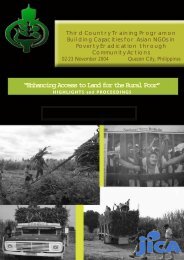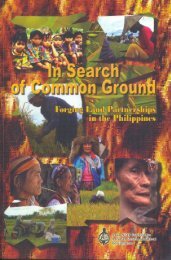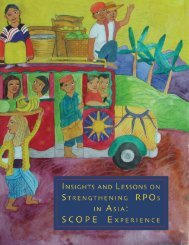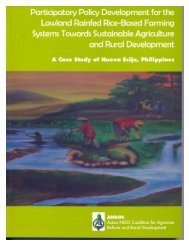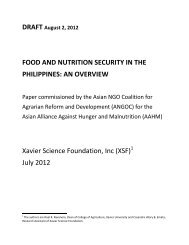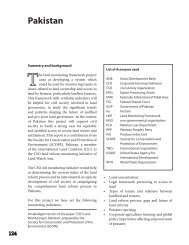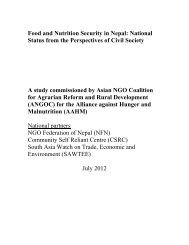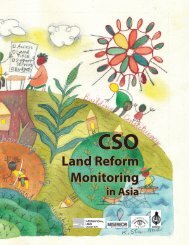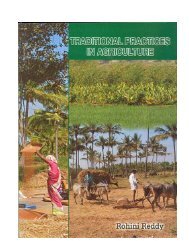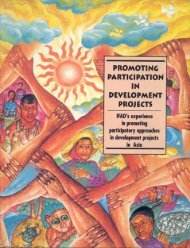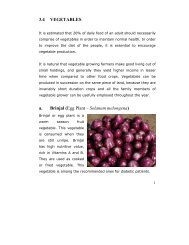Securing the Right to Land FULL - ANGOC
Securing the Right to Land FULL - ANGOC
Securing the Right to Land FULL - ANGOC
You also want an ePaper? Increase the reach of your titles
YUMPU automatically turns print PDFs into web optimized ePapers that Google loves.
<strong>Land</strong> Ownership and Distribution<br />
In 1999, 5% of landowners held close <strong>to</strong> 60% of all privately<br />
held land. By 2003, <strong>the</strong>ir share had risen <strong>to</strong> 70%.<br />
This means that <strong>the</strong> <strong>to</strong>p 5% of landowners are increasing<br />
<strong>the</strong>ir control of private lands by 2% per year.<br />
Farming households own an average of 1.5 hectares of land.<br />
However, 40% of households own less than 0.5 hectare.<br />
Twenty (20) percent of rural people are landless.<br />
CASE STUDY #2<br />
The rights of indigenous peoples are protected<br />
by a number of international declarations<br />
and conventions that were ratified<br />
by <strong>the</strong> Cambodian Government. These guarantees,<br />
combined with provisions in <strong>the</strong> <strong>Land</strong><br />
Law of 2001, should provide ample protection<br />
for traditional forms of landownership.<br />
But reality provides a jarring contrast <strong>to</strong> what<br />
<strong>the</strong> law intended. In <strong>the</strong> 1990s large tracts<br />
of ancestral lands of Cambodia’s indigenous<br />
peoples were allocated as forest and economic<br />
concessions by <strong>the</strong> Government. In January<br />
2008, it was found that “not a single indigenous<br />
community [had] received a title <strong>to</strong><br />
its collective property.”<br />
Even without a formal title, indigenous<br />
peoples have certain property rights, for example,<br />
user rights, by virtue of <strong>the</strong> Forest Law.<br />
OVERCOMING A FAILURE OF LAW AND POLITICAL WILL<br />
The Dispossession of Cambodia’s Indigenous Peoples<br />
However, from 2002 <strong>to</strong> 2008, <strong>the</strong>re has been<br />
a rash of land transfers from indigenous communities<br />
<strong>to</strong> provincial and Phnom Penh-based<br />
elite interests. Despite <strong>the</strong> existence of laws<br />
meant <strong>to</strong> protect indigenous peoples’ culture<br />
and rights, <strong>the</strong> continuing failure <strong>to</strong> implement<br />
such laws has led <strong>to</strong> widespread dispossession<br />
of indigenous communities and<br />
poses a continuing threat <strong>to</strong> <strong>the</strong>ir way of life.<br />
The NGO Statement on <strong>the</strong> Moni<strong>to</strong>ring of CG<br />
Indica<strong>to</strong>rs (June 2006) urges <strong>the</strong> Government<br />
<strong>to</strong> declare “that all land transactions in indigenous<br />
areas are illegal and that buyers will<br />
not receive ownership titles <strong>to</strong> illegally acquired<br />
land.”<br />
The failure <strong>to</strong> implement national laws is<br />
not <strong>the</strong> only problem. Until now <strong>the</strong> Government<br />
of Cambodia has not yet ratified Con-<br />
63<br />
Only 20% of landowners in Cambodia hold secure title <strong>to</strong><br />
<strong>the</strong>ir land.<br />
<strong>Land</strong>lessness is a key indica<strong>to</strong>r of vulnerability <strong>to</strong> poverty.<br />
The following landless groups are especially vulnerable:<br />
> Female headed households. The rate of landlessness<br />
among female headed households is 21.2%.<br />
> Rural families, especially female-headed ones, that rely<br />
on common property resources, such as public land and<br />
water, are more likely than most <strong>to</strong> fall victim <strong>to</strong> land<br />
grabs, insecure land tenure, and food insecurity.<br />
> People who live in or next <strong>to</strong> concession areas.<br />
> Residents of informal settlements in urban areas.<br />
> Indigenous peoples.<br />
Issues Affecting Access <strong>to</strong> <strong>Land</strong><br />
and Tenurial Security<br />
Rising Demand for <strong>Land</strong> as an Economic Asset<br />
Because of economic growth and development, <strong>the</strong> demand<br />
for land is increasing and land values are going through <strong>the</strong><br />
roof. Even if overall population densities are fairly low in Cam-<br />
vention No. 169 Concerning Indigenous and<br />
Tribal Peoples (1989) of <strong>the</strong> International<br />
Labour Organization (ILO). This convention<br />
seeks <strong>to</strong> protect indigenous peoples as a<br />
workforce on <strong>the</strong>ir land, and thus <strong>the</strong>ir way<br />
of life. An important provision of this convention,<br />
Article 14.3, obligates <strong>the</strong> State <strong>to</strong><br />
take all necessary steps <strong>to</strong> fully implement<br />
international laws for <strong>the</strong> protection of indigenous<br />
peoples at <strong>the</strong> national level. If <strong>the</strong><br />
Cambodian Government were <strong>to</strong> ratify this<br />
convention, it would find itself in a bind; hence,<br />
it is wavering in signing <strong>the</strong> convention.<br />
ASIAN NGO COALITION FOR AGRARIAN REFORM AND RURAL DEVELOPMENT



